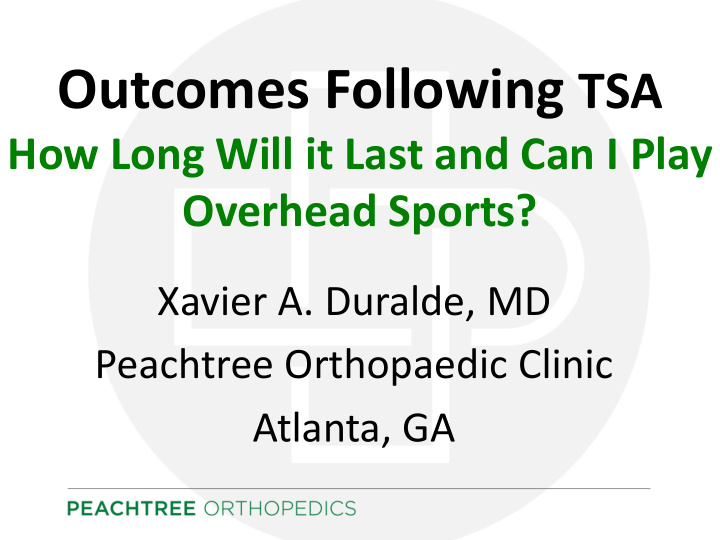



Outcomes Following TSA How Long Will it Last and Can I Play Overhead Sports? Xavier A. Duralde, MD Peachtree Orthopaedic Clinic Atlanta, GA
Outcomes Following TSA How Long Will it Last and Can I Play Overhead Sports? Smith + Nephew: Consultant CORR Board GOS Board
Disclaimers • Variety of prostheses • Selection bias by surgeons • Definition of failure • Surgical technique • Quality of evidence
Anatomic TSA • Torchia, et al Mayo Clinic 1997 – First long term study – 113 anatomic TSA; f/u 12.2 years (5-17yrs) Xray f/u 9.7 years • 10 year survival 93%; 15 year 87% • 44% of glenoids definitely loose • Press fit humeral stem shift in 49%; cemented shift 0% • TSA “survival” 87% but only 68% sat@ at 12
Anatomic TSA Quotable Longevity • Deshmukh, et al, 2005 – > 10 yr fu on 72 patients – Survival to revision • 5 year 98% • 10 year 93% • 15 year 88% • 20 year 85%
Anatomic TSA Implant Survival vs Glenoid Loosening • Walch, et al 2011 – 5 year fu – Revision 0.3%; glenoid loosening 0.3% – 10 year fu – Revision 1.7%; glenoid loosening 51.5% • Fox, et al 2013 Mayo – Implant survival; 5yrs 99% ; 10yrs 93% – Xray stable glenoid; 5yrs 99%; 10yrs 67%
What About Young Patients? • Roberson, et al Systematic Review TSA in patients <65 – Average fu 9.4 years – Revision rate 17.4% – Glenoid lucency 54% – Survival Rates • 5 yr 98-100% • 10 yr 62-92% • 20 yr 83-89%
What About Young Patients? • Wagner, et al 2017 Mayo – Role of age – 5494 arthroplasties 1970-2012 – 3% decrease in risk of revision/year of age between ages of 40-85 – Increase in risk of revision for mechanical failure in patients younger than 50 by 13%/ year
HHR Long Term Results • Levine, et al 2012 – 25 patients with HHR for GH OA – Follow up 17 yrs (13-21) – 8 required revision – Patient satisfaction • 2.4 yrs 74% • 7.9 yrs 61% • 17.2yrs 25%
TSA vs HHR • Sperling, et al 2004 – 78 HHR; 36 TSA – Minimum fu 15 years – Survival • HHR 10yrs 82% 20yrs 75% • TSA 10yrs 97% 20yrs 84% – Revision • HHR 22% • TSA 14%
Reverse TSA • Bacle, et al 2017 France – 87 RTSA with > 10 yr fu – Prosthetic survival 93% at 10 yrs – Scapular notching 73% – 29% complications; 12% rev – Deterioration of Constant score beginning sometime between year 6 to 8
Return to Sports What do Surgeons Allow? • Allowed: Low impact such as swimming, dancing, bowling, doubles tennis and bicycling • Allowed with experience: Golf, ice skating and downhill skiing • Not recommended: Hockey, rock climbing, gymnastics, football • No consensus: Baseball/softball, lacrosse, rowing, soccer, weightlifting, • Healy 2001; Survey of 35 ASES surgeons
Return to Sports What do Surgeons Allow? • Magnussen 2011; Survey ASES/SESEC – Allowed by prosthetic type • Swimming TSA 82%; HA 87%; RTSA 45% • Golf TSA 75%; HA 77%; RTSA 45% • Dbls tennis TSA 48%; HA 45%; RTSA 15%
Return to Sports What are patients actually doing? • 60-97% of patients return to • RTS is prosthetic- sport post arthroplasty type specific – TSA 93% • 84% of those return to upper – HHR 71% extremity sports – RTSA 75% – Fishing, swimming, golf, – Bulhoff 2014, McCarty 2008, fitness, tennis most popular Zarkadas 2011, Lawrence 2012, Garcia 2015, 2016, Liu 2017
Return to Sports How safe is it? • Jensen and Rockwood 1998 – TSA - 24 golfers compared to 76 nongolfers – No increase in RLL at 52 months • Simovitch 2015 – 40 patients with RTSA – One zone of lucency on humeral stem in 17% and 7% notching at 43 months
What Do I Allow? • Avoid high impact – No wood splitting – Occasional tennis – No contact sports • OK with: – Weightlifting (15 reps), RC program – Golf (especially back arm) – No divot for 6 mos – Swimming
Keeping My Fingers Crossed • Don’t worry Doc, I don’t do sets with more than 225 lbs! 2 years
Take Home Points • 1. Shoulder arthroplasty is a reliable operation with good reasonable long-term durability – Survival to revision Anatomic TSA • 5 yrs 98% ---------------10 yrs 93% • 15 yrs 88%---------------20 yrs 85% • 2. aTSA outperforms and outlasts HHR – Survival • HHR 10yrs 82% ----------20yrs 75% • TSA 10yrs 97% ---------20yrs 84%
Take Home Points • 3. Glenoid RLL generally appear about 5 years • 4. We don’t know the impact of rotator cuff failure or glenoid RLL will have on longer term studies regarding shoulder implant survival – stay tuned • 5. Reverse TSA survival is not too different from Anatomic TSA – 93% survival at 10 years
Take Home Points • 6. Surgeons allow greater activity after shoulder arthroplasty when there is no glenoid component but anatomic total shoulder arthroplasty has the highest return to sport of all the types of shoulder arthroplasty
Take Home Points • 7. Most patients (60-97%) return to sport following arthroplasty with many returning to upper extremity sports • 8. There are no long-term studies regarding the safety of return to sport in terms of implant survival
Xavier A Duralde, M.D. Peachtree Orthopedics
Recommend
More recommend